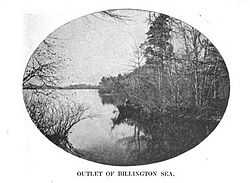Billington Sea
| Billington Sea | |
|---|---|
 | |
| Location | Plymouth, Massachusetts |
| Coordinates | 41°56′30″N 70°40′36″W / 41.94167°N 70.67667°WCoordinates: 41°56′30″N 70°40′36″W / 41.94167°N 70.67667°W |
| Primary outflows | Town Brook |
| Basin countries | United States |
| Surface area | 269 acres (1.09 km2) |
| Average depth | 7 ft (2.1 m) |
| Max. depth | 11 ft (3.4 m) |
| Islands | Seymour Island |
| Settlements | Billington Sea village |
Billington Sea (also Billington's Sea) is a 269-acre (1.09 km2) warm water pond located in Plymouth, Massachusetts. Morton Park lies on the pond's northern shore. The pond is fed by groundwater and cranberry bog outlets. The average depth is seven feet and the maximum depth is 11 feet (3.4 m). The pond provides the headwaters to Town Brook. Seymour Island is located in the center of the pond.
Billington Sea was named after its discoverer, Francis Billington, one of the passengers on the Mayflower who sighted the pond from a tree in January 1621.[1] By tradition, he had climbed a tree and, seeing a body of water, had the idea that he had found the "great South Sea" or the Pacific Ocean. In memory of his error, the pond has been called "Billington's Sea" since.[2][3]
Background
The Billington family may have originated from around Cowbit and Spaulding in Lincolnshire, England. Francis Longland named young children Francis Billington, son of John, and Francis Newton, son of Robert, as heirs. In 1650, a survey of lands indicated that Francis was "about 40" and living in New England. Francis himself stated in a 1674 deposition that he was 68 years old, so he was about 14 years old when he made the voyage on the Mayflower to Plymouth in 1620 with his parents John and Eleanor and older brother John.
Francis was clearly an active and troublesome youth. He nearly caused a disaster on board the Mayflower shortly after arrival, when he shot off his father's musket inside the Mayflower's cabin and sent sparks raining down near an open barrel of gunpowder. After he got to shore, he climbed up a tree and spotted a "great sea," which turned out to be a lake that even today is still known as "Billington's Sea". He and one of the Mayflower's crew members went to explore the sea, but became alarmed when they saw some abandoned Indian houses. They were alone with only a single gun.
John Billington, Francis' father, was hanged for murder in September 1630, and his brother John had died not too long before. In July 1634, Francis married Christian Eaton, the widow of Mayflower passenger Francis Eaton who had died the previous year autumn. Christian brought three of her own children and one stepchild from her previous marriage. All her children were under the age of 14. With Francis Billington, she had nine more children. They raised their family at Plymouth and moved in their later years to Middleboro, where they both died in 1684.[4]
Billington Sea village
Billington Sea is also the name of a small village on the southern shore of the pond along Black Cat Road, northeast of Micajah Heights and northwest of Lout Pond. Briggs Reservoir is located within the village south of Black Cat Road.
References
- ↑ Billington Sea (information provided by Commonwealth of Massachusetts)
- ↑ The Honorable Points of Ignorance The Atlantic Monthly vol. 91 page 501
- ↑ A Guide to Historic Plymouth James Baker, The History Press, 2008 142 pages, page 103
- ↑ http://www.mayflowerhistory.com/Passengers/FrancisBillington.php